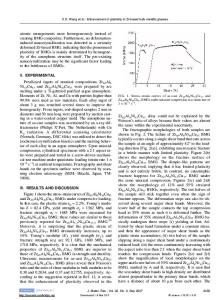Effect of testing conditions on the compressive plasticity of bulk metallic glasses
- PDF / 996,392 Bytes
- 9 Pages / 584.957 x 782.986 pts Page_size
- 17 Downloads / 369 Views
In this paper, the compressive behaviors of Zr-based bulk metallic glass (BMG) were experimentally studied under different testing conditions. To deeply reveal the inherent deformation mechanisms, numerical study was systematically conducted to analyze the shear banding evolution in BMGs, and the effect of testing machine stiffness, contact friction, and sample parallelism on the compressive ductility was therefore elucidated. Among them the effect of contact friction was carefully studied experimentally and the inherent deformation mechanisms was numerically analyzed in terms of the formation of shear bands. Free-volume theory was incorporated into ABAQUS finite element method code as a user material subroutine UMAT. The numerical method was firstly compared with the corresponding experimental results, and then parameter analyses were performed to discuss the impacts of testing conditions on the malleability of the BMG samples. The present work will shed some light on the interpretation of failure mechanisms in BMGs under different loading conditions.
I. INTRODUCTION
Bulk metallic glasses (BMGs) exhibit many superb properties, e.g., exceptionally high strength, large elastic limit, high hardness, good corrosion resistance, and reduced sliding friction, etc., which render them to be regarded as prospective candidates of engineering materials. However, their structural applications are severely stymied by the intrinsic limited plasticity, which is confined to narrow regions that are called shear bands at room temperature below their glass transition temperature. Therefore, the plastic deformation capability should be one of the most important properties for BMGs, and an accurate testing procedure is bound to be of great significance. Since many factors can affect the measured result, understanding their effect on the mechanical performance should be a necessary prerequisite. In the past decade, many works have been conducted to analyze the reliance of the plasticity of BMGs on the structure factors such as the sample aspect ratio (the ratio of height to width of sample), notch shape, notch configuration, and so on. Due to their convenience and accuracy, the uniaxial compression experiments are commonly adopted to measure the fundamental properties for BMGs. Park et al.1 determined the stress–strain curves of Zr-based BMG at high strain rates by the compression test at a temperature in the super-cooled liquid region, and carried Contributing Editor: Jörg F. Löffler a) Address all correspondence to this author. e-mail: [email protected] DOI: 10.1557/jmr.2016.291
out finite element method (FEM) calculations for clarifying the role of the solid metal lubricant during compression. Wu et al.2 experimentally confirmed that with decreasing sample dimension, the compressive plastic strain of a Zr-based BMG increases from near zero to as high as 80% without failure. A concept of critical shear offset is proposed to explain the strong size effect on the enhanced plasticity by taking the shear fracture energy density into account.
Data Loading...











